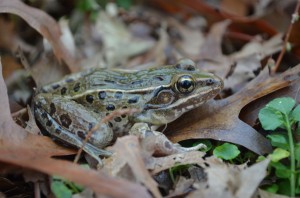
A yet, unnamed frog species that for the last century scientists thought was a more common leopard frog. Photo Credit: Brian Curry, Rutgers University.
March 14, 2012
So much for the notion that new species are never found in America. Now that is a myth well worth debunking.
A new frog species has been discovered in the USA.
The yet unnamed amphibian is believed to have lived among us for a century without being recognized
In New York City – in the midst of some of the world’s tallest skyscrapers – and within view of the Statue of Liberty, scientists have found a new frog species.
While discovering new species in remote rainforests is common, finding this one in the ponds and marshes of Staten Island, mainland New York, and New Jersey was a big surprise to the scientists from Rutgers University, UCLA, UC Davis, and the University of Alabama who worked together to make the discovery .
The yet unnamed frog – which biologists historically mistook for a more widespread variety of the leopard frog — may even extend into parts of Connecticut and extreme northeastern Pennsylvania. Researchers believe that these are likely the same leopard frogs that completely disappeared from Long Island and other parts of the area over the last few decades.

A yet, unnamed frog species that for the last century scientists thought was a more common leopard frog. Photo Credit: Brian Curry, Rutgers University.
“It is very surprising for a new species like this to have been unrecognized in this area until now,” said Rutgers doctoral candidate and guest researcher at Brookhaven National Laboratory Jeremy Feinberg, who made the initial discovery. “Their naturally limited range coupled with recent unexplained disapperances from places like Long Island underscores the importance of this discovery and the value that conservation efforts might have in the long-term survival of this urban species.”

Jeremy Feinberg, co-author of the study, and doctoral student in the School of Environmental and Biological Sciences
In newly released research, available online in the journal Molecular Phylogenetics and Evolution, scientists used mitochondrial and nuclear DNA data to compare the new frog to all other leopard frog species in the region and determined that it is an entirely new species, soon to be named by the researchers. The wetland species likely once lived on Manhattan, and though it’s now only known to live in a few nearby locations, Yankee Stadium would probably be the bull’s-eye of a target drawn around its current image.
Feinberg, co-author of the study, is working on his doctoral thesis in the School of Environmental and Biological Sciences. He was doing research on the alarming decline of leopard frogs in the wetlands of New York and New Jersey when he noticed that the regional leopard frogs displayed unusual behaviors and peculiar croaks. Instead of the “long snore” or “rapid chuckle” he heard from other leopard frogs, this frog had a short, repetitive croak.
“When I first heard these frogs calling, it was so different, I knew something was very off,” Feinberg said. “It’s what we call a cryptic species: one species hidden within another because we can’t tell them apart by looking. But thanks to molecular genetics, people are really picking out species more and more that would otherwise be ignored.”
To find out if his hunch was right, Feinberg developed a partnership with Cathy Newman, a geneticist who was completing a master’s degree in genetics at the University of Alabama.
The two decided to team up on the project after Newman, who was working on an unrelated study of leopard frogs, asked Feinberg, an ecologist and regional amphibian and reptile expert, for assistance with her research. In this heavily urbanized area Newman expected the frogs to be either of two previously known species, or perhaps a hybrid of both at best. What she found turned out to be a totally new species.
“I was very confident that the genetic results were going to support the idea that this was a new species” Feinberg said. “As Joanna Burger, professor in the Department of Cell Biology and Neuroscience, and Jeremy Feinberg’s advisor on the project far back as the late 1800s scientists have speculated about the odd frogs but until the advent of molecular genetics, it was difficult to prove anything.”
Although the frogs were discovered in the New York, New Jersey metropolitan area, the bulk of the genetics research took place at UC Davis. The results of those “unusual frogs” whose weird sounding calls were different from leopard frogs were clear-cut: the DNA was distinct, no matter how much the frogs looked alike.
What this discovery proves, said Joanna Burger, professor in the Department of Cell Biology and Neuroscience in the School of Arts and Sciences, and Feinberg’s advisor on the project, is that even in densely-populated urban areas new species can be found. Because of the extensive extinctions over the last few decades from habitat destruction, disease, invasive species, pesticides and parasites, it is even more imperative that conservation concerns be addressed, Burger said.
“It is amazing to discover a new frog in Rutgers backyard and the metropolitan area of New York and New Jersey that was among us for a century without being recognized,” Burger said. “We need to do all we can to make sure that we protect it.”

Joanna Burger, professor in the Department of Cell Biology and Neuroscience, and Jeremy Feinberg’s advisor on the project.
Thanks to a news release from Rutgers University.
About Loren Coleman
Loren Coleman is one of the world’s leading cryptozoologists, some say “the” leading living cryptozoologist. Certainly, he is acknowledged as the current living American researcher and writer who has most popularized cryptozoology in the late 20th and early 21st centuries.
Starting his fieldwork and investigations in 1960, after traveling and trekking extensively in pursuit of cryptozoological mysteries, Coleman began writing to share his experiences in 1969. An honorary member of Ivan T. Sanderson’s Society for the Investigation of the Unexplained in the 1970s, Coleman has been bestowed with similar honorary memberships of the North Idaho College Cryptozoology Club in 1983, and in subsequent years, that of the British Columbia Scientific Cryptozoology Club, CryptoSafari International, and other international organizations. He was also a Life Member and Benefactor of the International Society of Cryptozoology (now-defunct).
Loren Coleman’s daily blog, as a member of the Cryptomundo Team, served as an ongoing avenue of communication for the ever-growing body of cryptozoo news from 2005 through 2013. He returned as an infrequent contributor beginning Halloween week of 2015.
Coleman is the founder in 2003, and current director of the International Cryptozoology Museum in Portland, Maine.
Filed under Breaking News, CryptoZoo News, New Species